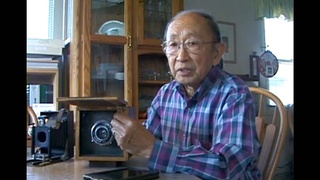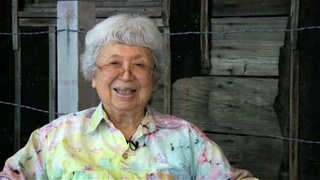Interviews
Father in camp but learning from history books
Oh, just my father was in concentration camp. Again, it’s a typical Japanese American household, you don’t hear very much about it, it’s kind of quiet, so I think I read more about it in books than I have been hearing about it by my actual, my father, but in the end, he was ten, or ten years old maybe, or twelve years old in the camp so, it was a big part of his childhood, but in the end, it’s still a pretty quiet subject.
I think that, I’m glad I can read about it in books, but in the end, you know, personal experience is important and I’d like to hear more about it. It’s something that you know, I don’t even know if he wants to talk about, it’s not something that he’s angry about, but it’s also something hard for me to ask about, ‘cause I know the answers are usually quite short (laughs).
But, I think in the end, I mean, I you know, did my reading on it, and I know the history behind it. I still don’t know why it had to happen, but in the end, you know, it’s one of those things that where, it’s just a big part of our, you know, part of Japanese American history in America, so I mean, it’s my job to know about it.
Date: November 27, 2005
Location: California, US
Interviewer: John Esaki and Janice Tanaka
Contributed by: Watase Media Arts Center, Japanese American National Museum
Explore More Videos

His father describes the importance of photographing camp life
(1924-2016) Photographer and businessman.

Importance of education in achieving redress for incarceration
(1919-2014) Activist for civil rights and redress for World War II incarceration of Japanese Americans.



The birth of a novel through a conversation with her nephew
(b. 1934) Writer


Mixed emotions after declaration of war on Japan
(b.1913) Kibei from California who served in the MIS with Merrill’s Marauders during WWII.


Train ride to Jerome Relocation Center
(b.1913) Kibei from California who served in the MIS with Merrill’s Marauders during WWII.

Atmosphere in his Merrill’s Marauders unit when surrounded by Japanese soldiers
(b.1913) Kibei from California who served in the MIS with Merrill’s Marauders during WWII.


Response to loyalty questionnaire
(b.1909) Nisei from Washington. Incarcerated at Tule Lake and Minidoka during WWII. Resettled in Chicago after WWII

Larry designing chairs in the camp
Sister of automotive designer Larry Shinoda

Move from Tule Lake to Minidoka
(b.1909) Nisei from Washington. Incarcerated at Tule Lake and Minidoka during WWII. Resettled in Chicago after WWII

Under suspicion after Pearl Harbor
(b. 1924) Political scientist, educator, and administrator from Hawai`i
